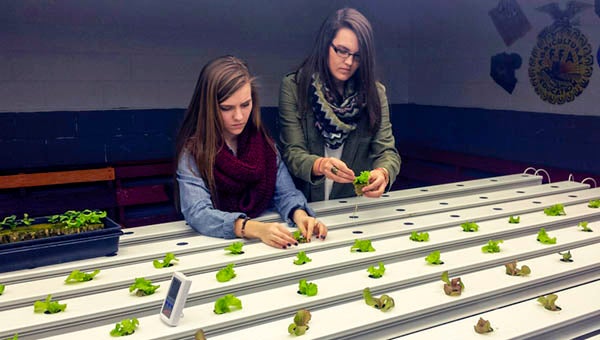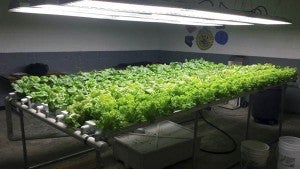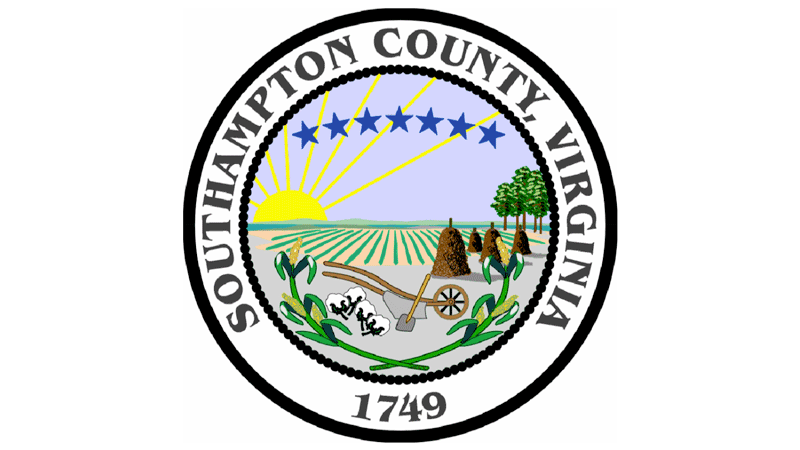Southampton students learn non-traditional farming methods
Published 12:28 pm Friday, September 25, 2015

Students in Chad Brock’s agriculture program prepare the hydroponics table with lettuce seedlings. This is Southampton’s second year teaching hydroponics. — SUBMITTED
COURTLAND
Aquaponics and hydroponics are redefining farming techniques by using substantially less water to grow crops, and students in Southampton High School’s agricultural program are learning how to improve food production and lower food costs with the help of this new technology.
“When I was in high school taking agriculture classes, it was based on traditional farming — animal husbandry and row crops,” said agriculture teacher Chad Brock. “The focus is not on those kids anymore. You’re not teaching to that traditional farmer anymore. It’s become, ‘I own an acre. What can I do with it?’”

Students in Chad Brock’s agriculture program prepare the hydroponics table with lettuce seedlings. This is Southampton’s second year teaching hydroponics. — SUBMITTED
In the hydroponics course, students are learning how to grow plants without soil. Instead, they plant seeds in rock wool, a man-made fiber created by heating and crushing rocks into an absorbent insulation-like material, and filter light and water through it at a constant pace. The contraption in which this is done, known as a hydroponic table, looks like little more than PVC pipe with holes drilled in it and a florescent light hanging above.
“The kit, including the lights and table, costs somewhere around $5,200, and it grows about 180 heads of lettuce,” he said. “You could make it yourself out of some household guttering by drilling some holes in it.”
Southampton started its hydroponics program in 2014 because it is mandated that every high school student have a certification in a career and technical program — or a workplace ready certification if their desired program is not offered — but Brock said he thinks that it is a program with wider-reaching benefits.
“These programs are going to help them get the job when they go to an interview,” he said. “If all you learned was math and science, then you don’t know how to apply it. The students come down here and they check the pH [balance] and the dissolved solids in the water and maintain the temperature. They learn about that stuff in chemistry class, but they don’t know why it affects [the plants]. Here, they get to see that in action.”
A graduate of Southampton High School, Brock went to Paul D. Camp Community College and transferred to Virginia Tech for its forestry program. He had long known he wanted to help children learn about agriculture, though.
“I ended up coming out with a landscaping degree thinking that I would start my own business,” he said. “Come to find out, I’m not a financial risk taker.”
Brock worked at the paper mill for several years before being hired as a teacher at Southampton.
“I always felt like I wanted to work with kids,” the 12-year teaching veteran said. “They called and next thing I know, I’m teaching agriculture.”
Now, he heads an agricultural program that will compete at the end of this month with other schools at the Virginia State Fair in categories such as forestry, crops judging and lawn tractor safety.
“These kids are proving, although it’s not an SOL (Standards of Learning test), that they are able to compete with 30 or 40 other high schools to say, ‘We’re learning the same stuff that you guys are, but we’re learning it better.’
“It’s very important to show that you can apply what you learn, not just take a test. You may be an ‘A’ student in class, but you can’t drive a nail … If they want, employers can pull their competency record and see how they perform.”
Another facet to the aquaponics, horticulture and landscaping coursework at Southampton is the construction of a 30-by-48 greenhouse. The $26,828 arboretum was paid for by a Perkins grant, which provides funds to improve the quality of career and technical education for students.
Brock said he expects the project to be completed early next month.
“I’m talking to local business owners who are in a similar field like Grayson and Emma’s, Southern Charm and Cross Country Farms in Zuni,” he said. “We don’t want to get in a situation where we’re competing with private industries because then they’re not going to be as inclined to help us. We’re seeing what we can grow to complement what they’re doing, so we’ve gotten some good ideas with that about what they don’t grow that we can do.
“We’re just doing lettuce at this time, but when we get the greenhouse up and running, we’re going to experiment with other things,” Brock continued. “You have to have a specific level of fertilizer and pH balance that you have to have for certain crops, and anything we have growing [inside] gets long and leggy because it’s trying to grow toward the light.”
Brock explained that natural light will allow for the crops to grow naturally, and receive an even amount of daylight and darkness that they aren’t afforded under the florescent light at all hours of the day.
“That’s another reason I’d like to get another table, just to compare whether it would do better with natural sunlight for half the day or the artificial light for 24 hours.”
He said that they still teach students who farm in more traditional methods, and that’s why they’ve continued to tend to the raised gardens outside the school where they plant collards, cabbage, broccoli, kale and radishes.
Students in the program also raised tilapia in a small pond in their classroom to pair with their homegrown lettuce and the end-of-year fish taco banquet.
“What we did at the end of the year with the culinary arts program is that we harvested the fish, took them down the hall for them to fillet them and they made fish tacos,” Brock said. “We obviously had the lettuce for it, too.”
The program has exceeded expectations and will only expand in the coming years, he said. The fish taco dinners will continue, too, but Brock hopes more so that the hydroponics course has made a significant impact on the students he’s taught so far.
“All these kids won’t be able to afford a greenhouse, but anybody can afford a sheet of plywood and make a raised bed or some PVC pipe,” he said. “Hopefully, they leave the program with a little bit of self-confidence and that they take what they’ve learned and do something with it.”





